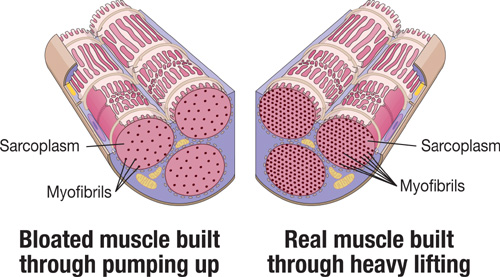
YOU LIKE BURN? LIGHT A MATCH.
—DR. FRED HATFIELD
You tried high reps. You went for the “burn”. It did not work. Why do you insist on doing the same thing and expect a different outcome?
The “burn” you feel from high reps is from lactate buildup and does absolutely nothing for toning up your muscles. I remember picking up a copy of The Guinness Book of World Records and seeing a picture of the gent who held the record for the number of consecutive sit-ups—many, many thousands. This martyr must have “felt the burn” more than anyone else on this planet, yet he did not even have a six-pack to show for it, in spite of his low level of body fat.
To know why high reps have failed this Comrade and many others, one must understand what makes abs hard and strong. It is a combination of increased resting tension or tonus and “real” muscle growth.
Muscle tone is simply residual tension in a relaxed muscle. And tension is the means by which a muscle generates force. The more tiny strands of contractile proteins hook on to each other, the more tension and force the muscle produces, the more tone it exhibits. Contrary to popular belief, a resting muscle is not totally relaxed—your body would have collapsed into a bag of bones if it were—but partially tensed, preloaded to spring into action.
The English words “tone” and “tune” were derived from the same Old French word: ton. It is no surprise that muscle tone has been poetically likened to the tautness of a guitar string. Think of “toned” muscles as “tuned for action”.
Of course, one must differentiate between tight muscles and toned muscles. The former are short and stiff, the latter long and vibrant, ready to go off like a drawn bow. Stand up and imagine that you are about to get punched in the stomach. Brace your abs without hunching over. This is what good muscle tone feels like.
Muscles get short because they don’t get much of an opportunity to be long. One scenario is inactivity and bad posture. When a person spends a lot of time sitting, his abs shorten. Because he is lazy, they also weaken. As they get weaker, they get tighter.
In another scenario, the person does strength train but only through a short range of motion: consider the permanently bent arms of a bodybuilder.
The third scenario is akin to rigor mortis. Your muscle fibers are like mousetraps—they go off by themselves, but need energy to be reset to contract again. A dead body is out of ATP, the energy compound that relaxes the muscles. Thus the muscles of a “stiff” are permanently contracted. A typical high rep ab workout exhausts ATP in the muscles and they lock up like those of a dead man. This is spasm, not tone, and it is produced by popular abdominal routines. Such “zombie tone” does not last—you have to “kill” the muscles day in and day out with mind numbing reps.1
Like a mousetrap that has already fired but cannot be reset, a short, tight muscle is worthless in sports.
A muscle with a healthy muscle tone will also have a substantial number of fibers that are active at all times—but at a greater length. The mousetrap is loaded.
To acquire such tonus one must do three things.
First, train the muscles with high tension. It should be apparent that one cannot maintain high levels of tension for a long period of time. Over decades of experience, strength coaches have determined that five reps are about all one can do and fewer are just fine.
Second, prevent the muscle from shortening:
a) Stretching after strength training;
b) Doing at least some strength exercises through a long range of motion;
c) Training the antagonists (the back extensors in the abs’ case)
Healthy muscle tone is the first prerequisite for rock hard abs; “real” muscle growth is the other.
There are two types of muscular hypertrophy: sarcoplasmic and myofibrillar. The former increases the number of capillaries and blows the muscle up with glycogen and other energy compounds needed to endure the demands of high reps. And one molecule of glycogen binds three molecules of water. Now you know what bodybuilders’ bloated bi’s are made of. The latter, spurred by heavy resistance, increases the size of the fibers’ contractile apparatus or myofibrils—the “real” muscle of a lifter or gymnast.

“Which type of hypertrophy is going to develop depends on the nature of training,” explains Prof. Evgeniy Ilyin. “Prolonged dynamic efforts with a small load lead to the first type of hypertrophy; large muscle tensions in isometric regime—to the hypertrophy of the second type.”
What is fascinating about myofibrillar hypertrophy from the standpoint of looking good is, (I quote the Russian professor), “The muscle’s cross section may change insignificantly, as what mostly changes is the density of packing of the myofibrils in the muscle fiber.” In other words, heavy weights make muscles dense and hard but not really big. Doesn’t this sound like the abs you are after?
Some will argue: “Why would I train the abs with low reps? These are slow twitch muscles!”
First, this may or may not be true as the research is inconsistent.3 But we do know that there are large individual differences in the percentage of slow Type I fibers in the rectus abdominis or RA: 32-76%.4
Second, your abbies’ fiber composition is irrelevant. If your goals are strength and muscle definition you should go after your fast twitchers, whatever their percentage may be. Here is a fascinating gold nugget of research that has somehow escaped the eyes of bodybuilders for over four decades: faster muscle fibers congregate near the surface of the muscle and slower ones hide deep inside!5 Which could explain why lean strength athletes—power-lifters, weightlifters, gymnasts, etc.—display remarkably dense muscles and “high reppers” tend to stay soft.

Powerlifting champion Ausby Alexander proves the point that heavy lifting produces exceptional abs. Of course, they will show only if one stays lean as this Marine vet. Photo courtesy Powerlifting USA
Bulgarian gymnastics coach Ivan Ivanov likes to say that low rep, heavy training “shrinks” muscles into one piece, while bodybuilding style pump-up “blows them up”. It is instructive that Eugene Sandow, an iron legend equally famous for his strength and his physique, advised limiting the reps in abdominal exercises to three! Not surprisingly, he picked hard exercises like the straight arm, straight leg sit-up with dumbbells held overhead in straight arms.
Third, I presume you want your abs to play the part, not just look the part. Muscle size is only half of the strength equation. The other half is the nervous system’s ability to recruit the muscles and it can only be effectively developed with very brief efforts produced in a fresh state.6
Acquiring a killer six-pack becomes ridiculously simple and easy once you understand that you need to train your midsection for strength and not endurance. We have time tested simple and effective methodologies to do just that.
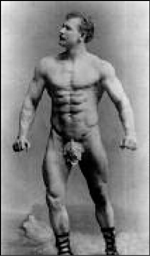
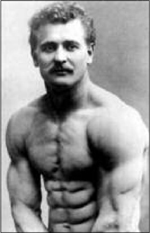
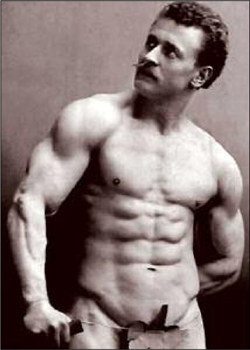
Eugene Sandow, an iron legend equally famous for his strength and his physique.
A Russian gave his friend a critical look: “Boy, you sure are getting fat, Comrade!”
The big Comrade finished chewing a piece of salted pork lard and responded pensively: “I aim for perfection! And what is the most perfect shape in the universe?” He paused for effect. “…The sphere!”

If this is not your idea of perfect shape, you had better lose the spare tire before taking on the Hardstyle Abs plan. Hardstyle breathing is not a good idea for heavy folks as they run a tendency towards high blood pressure and as for the Hardstyle sit-ups, your belly will quite literally get in the way. I am not even going to mention the hanging leg raise.
How to lose fat?—The keys are kettlebell swings and smarter eating. My book and DVD Enter the Kettlebell! will teach you the former. Someone else will teach you the latter.
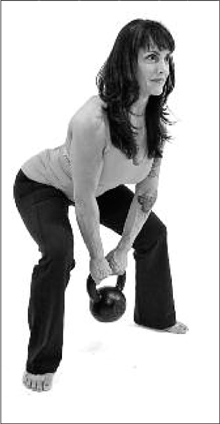

Tracy Reifkind, RKC lost 115 pounds through two weekly kettlebell swing workouts and better eating.
Before photo courtesy Tracy Reifkind
If you are already fairly lean, your upper abs are showing but the lower ones are not, the answer is losing even more fat. Aponeuroses, fibrous sheets performing the role of tendons for the obliques and transversus abdominis, pass over the six-pack beneath your belly button. So building and toning will not do much good there.
And as long as we are on the topic of the “upper” and “lower” abs, the top and the bottom of your rectus abdominis are indeed innervated separately. However, scientists cannot come to an agreement whether this means anything to your midsection training. Some believe that only in low intensity contractions may the lower or the upper abs be isolated. Others are convinced that well coordinated subjects can pull it off.7 Regardless, load the abs enough, and the whole length of your six-pack will light up like a Christmas tree.
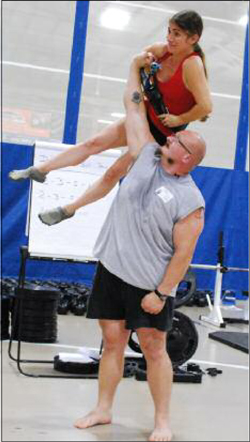
Professional strongman Bud Jeffries, RKC also dropped 115 pounds, most of it fat, through kettlebell swing specialization. “I’ve maintained all, or almost all of my strength… Interestingly I actually gained strength in several areas… massively gained grip strength… gained a lot of back strength.”